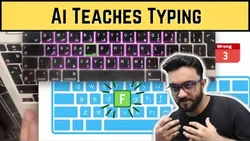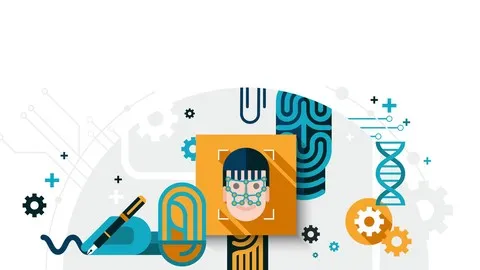
AI Typing Tutor using Opencv Python Computer Vision 
This course teaches students how to create an AI Typing Tutor using Opencv Python and Computer Vision. It covers topics such as face detection, sending data to Unity, creating the scene, getting data from Python, decoding data, moving the camera, camera rotation, and Y-axis movement smoothing. Students will learn how to use these tools to create an AI Typing Tutor. ▼
ADVERTISEMENT
Course Feature
![]() Cost:
Cost:
Free
![]() Provider:
Provider:
Youtube
![]() Certificate:
Certificate:
Paid Certification
![]() Language:
Language:
English
![]() Start Date:
Start Date:
On-Demand
Course Overview
❗The content presented here is sourced directly from Youtube platform. For comprehensive course details, including enrollment information, simply click on the 'Go to class' link on our website.
Updated in [February 21st, 2023]
AI Typing Tutor using Opencv Python Computer Vision is a comprehensive course that teaches learners how to use Opencv Python and Computer Vision to create an AI Typing Tutor. Learners will learn how to use Opencv Python to detect faces, send data to Unity, create the scene, get data from Python, decode data, move the camera, rotate the camera, and smooth the Y-axis movement. This course is suitable for learners who are interested in AI Tutoring, Python Programming, Opencv Tutorials, AI Learning, and Computer Vision Tutorials. Learners will gain a comprehensive understanding of how to use Opencv Python and Computer Vision to create an AI Typing Tutor.
[Applications]
The application of this course can be seen in the development of an AI Typing Tutor. After completing this course, users can use OpenCV Python Computer Vision to create a program that can detect a user's face and send the data to Unity. In Unity, users can create a scene, get data from Python, decode the data, move the camera, rotate the camera, and add smoothing to the movement. With these skills, users can create an AI Typing Tutor that can detect a user's face and track their movements.
[Career Paths]
1. AI Developer: AI developers are responsible for creating and maintaining AI systems. They use programming languages such as Python, C++, and Java to develop algorithms and software that can be used to automate tasks and make decisions. AI developers must have a strong understanding of mathematics, computer science, and machine learning. As AI technology continues to evolve, the demand for AI developers is expected to increase.
2. Machine Learning Engineer: Machine learning engineers are responsible for developing and deploying machine learning models. They use programming languages such as Python, R, and Java to create algorithms and software that can be used to automate tasks and make decisions. Machine learning engineers must have a strong understanding of mathematics, computer science, and machine learning. As AI technology continues to evolve, the demand for machine learning engineers is expected to increase.
3. Computer Vision Engineer: Computer vision engineers are responsible for developing and deploying computer vision systems. They use programming languages such as Python, C++, and Java to create algorithms and software that can be used to automate tasks and make decisions. Computer vision engineers must have a strong understanding of mathematics, computer science, and machine learning. As AI technology continues to evolve, the demand for computer vision engineers is expected to increase.
4. Robotics Engineer: Robotics engineers are responsible for developing and deploying robotic systems. They use programming languages such as Python, C++, and Java to create algorithms and software that can be used to automate tasks and make decisions. Robotics engineers must have a strong understanding of mathematics, computer science, and machine learning. As AI technology continues to evolve, the demand for robotics engineers is expected to increase.
[Education Paths]
1. Bachelor of Science in Computer Science: This degree path focuses on the fundamentals of computer science, such as programming, algorithms, data structures, and software engineering. It also covers topics such as artificial intelligence, machine learning, and computer vision. This degree path is ideal for those interested in developing software applications and systems that use AI and computer vision technologies.
2. Master of Science in Artificial Intelligence: This degree path focuses on the development of AI systems and applications. It covers topics such as machine learning, natural language processing, computer vision, and robotics. This degree path is ideal for those interested in developing AI-based applications and systems.
3. Doctor of Philosophy in Computer Science: This degree path focuses on advanced topics in computer science, such as artificial intelligence, machine learning, and computer vision. It also covers topics such as software engineering, algorithms, and data structures. This degree path is ideal for those interested in researching and developing AI-based applications and systems.
4. Master of Science in Robotics: This degree path focuses on the development of robotic systems and applications. It covers topics such as machine learning, computer vision, and artificial intelligence. This degree path is ideal for those interested in developing robotic systems and applications that use AI and computer vision technologies.
Course Provider

Provider Youtube's Stats at AZClass
Discussion and Reviews
0.0 (Based on 0 reviews)
Explore Similar Online Courses

Building a Selective Laser Sintering (SLS) 3D Printer!

How to Animate SPEED - Smears + Duplicate Limbs

Python for Informatics: Exploring Information

Social Network Analysis

Introduction to Systematic Review and Meta-Analysis

The Analytics Edge

DCO042 - Python For Informatics

Causal Diagrams: Draw Your Assumptions Before Your Conclusions

Whole genome sequencing of bacterial genomes - tools and applications

Introduction to Computer Vision

Learn Computer Vision with OpenCV Library using Python


Start your review of AI Typing Tutor using Opencv Python Computer Vision